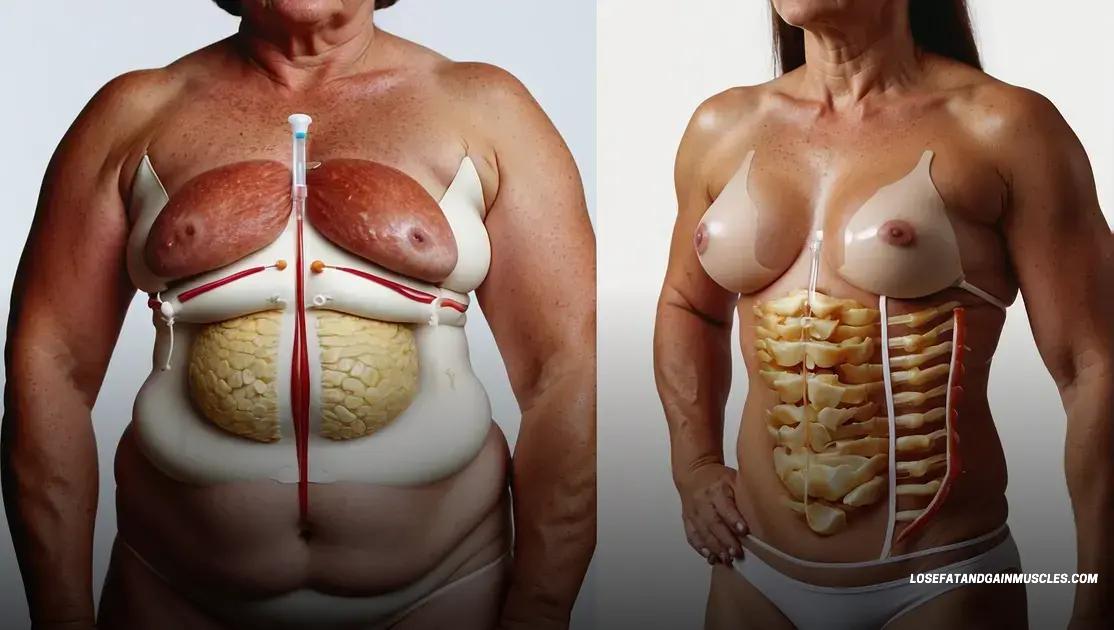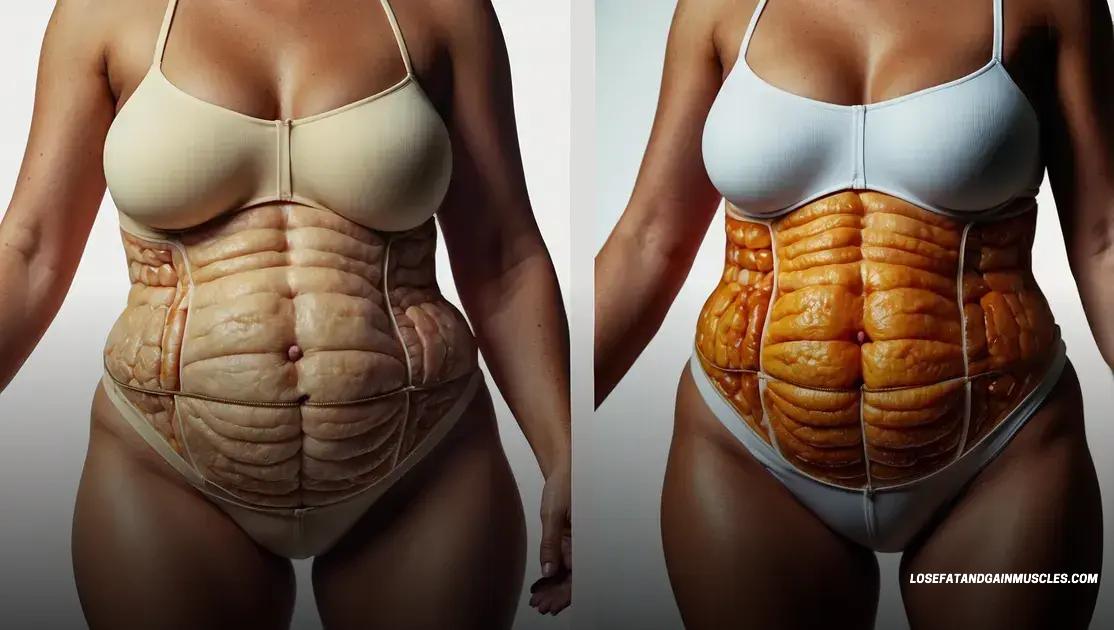Does Fat Get Jiggly Before You Lose It? Discover the Truth Now
Fat can get jiggly before you lose it due to factors like skin elasticity loss, hormonal changes, and rapid weight fluctuations. Effective strategies to reduce jiggly fat include strength training, a balanced diet, hydration, and good skincare practices.
Have you ever wondered if fat gets jiggly before you lose it? Many people experience changes in their body fat texture during weight loss. Understanding how and why this happens can provide insight into your own weight loss journey. In this article, we will explore the signs that indicate fat is being burned, what causes the fat to become jiggly, and effective tips to reduce jiggly fat in a healthy way.
Understanding the Texture of Fat Before Weight Loss
Understanding the texture of fat in our bodies is essential, especially during weight loss. Fat can exist in various forms, ranging from firm and smooth to soft and jiggly. These variations can indicate how the fat is responding to the weight loss process.
Prior to weight loss, fat tends to be more consolidated and firm. As the body begins to burn fat for energy, hormonal changes and the metabolic process can cause the texture of fat to soften and become more jiggly. This phenomenon often confuses many, leading them to wonder if all fat is the same.
Factors Influencing Fat Texture
The softness or firmness of fat is influenced by several factors:
- Genetics: Individual genetic makeup plays a crucial role in how fat is stored and its texture.
- Age: As people age, the elasticity of skin decreases, potentially leading to a softer appearance of fat.
- Diet: Diets high in sugar and processed foods can affect fat texture. Healthy fats, on the other hand, can help maintain skin elasticity by providing necessary nutrients.
Understanding these factors can help in accepting the changes that occur during the weight loss journey. It’s essential to know that the jiggly texture does not mean you are not losing weight; instead, it indicates that your body is undergoing transformation.
Conclusion
Awareness of how fat texture changes can help reduce anxiety during the weight loss process. Recognizing that your body has its unique way of losing fat is key to maintaining a positive mindset.
Signs That Indicate Fat is Being Burned

Recognizing the signs that indicate fat is being burned is crucial for anyone on a weight loss journey. These signs can vary from person to person, but several common indicators can help you understand if your body is effectively losing fat.
1. Changes in Measurements
One of the most reliable signs that fat is being burned is a change in your body measurements. If your waist, hips, or thighs shrink, it often means that fat is being lost, even if the scale doesn’t show significant changes.
2. Increased Energy Levels
As your body starts burning fat for energy, you may notice an increase in your overall energy levels. When your body shifts from storing fat to utilizing it, you often feel more energized throughout the day.
3. Enhanced Workout Performance
If you find that you can work out longer or with greater intensity, it might be a sign that your body is burning fat efficiently. Improved stamina and strength during exercises can indicate fat loss progress.
4. Changes in Appetite
While it might seem counterintuitive, a change in appetite can signal that your body is burning fat. If you find yourself feeling less hungry or more satisfied after meals, it could mean your body is adjusting to burning fat for energy.
5. Improved Mood and Mental Clarity
A surprisingly good indicator of fat burning is an improvement in mood and cognitive function. When your body efficiently burns fat, it can lead to better brain function and mood stabilization, making you feel happier and more focused.
Keeping an eye on these signs can help ensure that you’re on the right track with your weight loss efforts and encourage you to stay motivated throughout your journey.
What Causes Fat to Become Jiggly?
Understanding what causes fat to become jiggly can provide clarity during your weight loss journey. The texture of fat is primarily influenced by various biological and lifestyle factors. Here are some reasons why fat can become softer and jiggly:
1. Loss of Skin Elasticity
As we age, our skin naturally loses elasticity. This means that when fat is present, it may appear more jiggly because the skin cannot hold it as firmly as before. Enhanced aging can lead to more noticeable jiggle.
2. Hormonal Changes
Hormones play a key role in fat storage and texture. Changes in hormonal levels, particularly during puberty, pregnancy, or menopause, can lead to fluctuations in fat texture. Women may notice more jiggly fat due to estrogen levels affecting fat distribution.
3. Fat Composition
Not all body fat is the same. Subcutaneous fat, the layer of fat just beneath the skin, can often feel soft and jiggly compared to visceral fat, which is found deeper around organs. An increase in subcutaneous fat can lead to a jiggly appearance.
4. Diet and Lifestyle
High-sugar and high-fat diets can contribute to the accumulation of soft fat. A lack of exercise can also result in the body retaining fat in a soft, jiggly state. Improper nutrition can lead to poor skin health, which further adds to the texture changes.
5. Weight Fluctuations
Rapid weight loss can cause excess skin and fat to sag or become jiggly. When individuals lose weight too quickly, the skin may not have time to adjust, leading to a softer texture.
A combination of these factors can cause fat to become jiggly. Awareness of these contributors can promote healthier lifestyle choices and realistic expectations during your weight loss journey.
The Science Behind Fat Loss and Skin Changes

The science behind fat loss and skin changes is intricate and fascinating. Understanding how our bodies respond to fat loss can help alleviate concerns about changes in skin texture and appearance.
1. The Role of Fat Metabolism
When the body needs energy, it turns to stored fat. This process is known as fat metabolism. During fat metabolism, fat cells break down triglycerides into fatty acids and glycerol, providing energy for bodily functions. As fat is utilized, the volume of fat cells decreases, which can affect skin texture.
2. Skin Elasticity and Collagen Production
Skin’s elasticity is largely determined by collagen and elastin, proteins that provide support and flexibility. Fat loss can lead to decreased collagen production over time, especially with rapid weight loss. This can result in sagging or a jiggly appearance as skin struggles to keep up with the changes in fat volume.
3. Hormonal Factors
Hormones also play a crucial role in the skin’s response to fat loss. Hormonal fluctuations, especially during weight loss, can affect how fat is stored and lost. For instance, estrogen impacts fat distribution and skin health. Changes in hormone levels during dieting or exercise can lead to changes in skin structure.
4. Hydration and Nutritional Status
Proper hydration and nutrition are vital for maintaining skin health. When a person loses weight, if hydration and nutrient intake are not adequate, the skin can lose its plumpness, resulting in a less youthful appearance. Ensuring adequate vitamins and minerals can support skin elasticity during weight loss.
5. Aging and Weight Loss
Aging is an inevitable factor that affects both fat and skin. As individuals age, the natural loss of fat in certain areas can lead to sagging skin. Combining this with weight loss can enhance the appearance of jiggly fat since the skin may not retract as efficiently.
Understanding these scientific principles can better equip individuals navigating their weight loss journeys, helping them manage expectations and make informed choices for maintaining healthy skin.
Tips to Reduce Jiggly Fat Effectively
Reducing jiggly fat requires a combination of exercise, diet, and skincare practices. Here are some effective tips to reduce jiggly fat:
1. Incorporate Strength Training
Engaging in strength training exercises can help build muscle and tone areas affected by jiggly fat. Focusing on weightlifting, resistance bands, or body-weight exercises can enhance muscle definition and improve skin tightness.
2. Add Cardiovascular Exercises
Cardio workouts, like running, cycling, or swimming, can help burn calories and promote overall fat loss. Aim for at least 150 minutes of moderate-intensity cardio each week to help reduce jiggly fat effectively.
3. Eat a Balanced Diet
Focus on a nutritious diet rich in whole foods such as fruits, vegetables, lean proteins, and healthy fats. Reducing processed foods, sugars, and unhealthy fats can aid in fat loss and improve skin health.
4. Stay Hydrated
Drinking enough water is essential for maintaining skin elasticity and overall health. Aim for 8-10 cups of water daily to keep your skin hydrated and promote fat metabolism.
5. Practice Skin Care
Incorporating good skincare routines can improve the appearance of sagging skin. Regular exfoliation, hydration, and the use of creams containing collagen or elastin can help enhance skin texture and firmness.
6. Manage Stress
Reducing stress through mindfulness practices like yoga or meditation can help lower cortisol levels, which is linked to fat gain. A stress-free environment can aid in weight management and fat loss.
7. Get Enough Sleep
Quality sleep is vital for a healthy metabolism. Aim for 7-9 hours of restful sleep each night. Lack of sleep can lead to weight gain and increased fat retention.
By integrating these tips into your lifestyle, you can effectively tackle jiggly fat and improve your overall appearance as you continue your weight loss journey.
Understanding Fat Loss and Embracing Change
As we’ve explored throughout this article, the journey of fat loss brings about various changes in our bodies, including the texture of fat and how our skin responds. Recognizing the signs that fat is being burned and understanding the science behind these changes can empower you on your weight loss journey.
From knowing what causes fat to become jiggly to implementing effective tips for reducing it, being informed allows you to make positive lifestyle choices. Emphasizing strength training, maintaining a balanced diet, and practicing good skincare can significantly contribute to your goals.
Remember, it’s not just about the number on the scale but also about improving your overall health and well-being. Every person’s body is unique, and it’s essential to approach weight loss with patience and a positive mindset. With commitment and the right strategies, you can achieve your desired results.
FAQ – Frequently Asked Questions about Fat Loss and Skin Changes
Does fat get jiggly before losing it?
Yes, fat can become jiggly as part of the weight loss process due to changes in skin elasticity and fat texture.
What are the signs that fat is being burned?
Signs include changes in body measurements, increased energy levels, improved workout performance, changes in appetite, and enhanced mood.
What causes fat to become jiggly?
Factors include loss of skin elasticity, hormonal changes, the type of fat, dietary impacts, and rapid weight fluctuations.
How can I effectively reduce jiggly fat?
Incorporate strength and cardio training, eat a balanced diet, stay hydrated, and practice good skin care.
Is it normal for skin to sag after weight loss?
Yes, sagging skin is common due to decreased fat volume and skin elasticity. Maintaining a healthy diet and exercise can help.
What role does hydration play in fat loss?
Staying hydrated supports metabolism and skin health, which can help improve skin appearance and firmness during weight loss.













